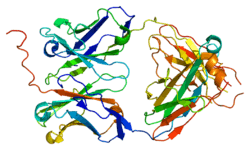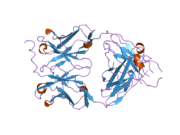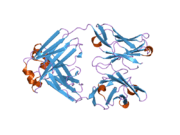VPREB1
| VPREB1 | |||||||||||||||
|---|---|---|---|---|---|---|---|---|---|---|---|---|---|---|---|
 |
|||||||||||||||
| |||||||||||||||
| Identifiers | |||||||||||||||
| Aliases | VPREB1, IGI, IGVPB, VPREB, CD179a, pre-B lymphocyte 1 | ||||||||||||||
| External IDs | MGI: 98936 HomoloGene: 84741 GeneCards: VPREB1 | ||||||||||||||
| RNA expression pattern | |||||||||||||||
 | |||||||||||||||
| More reference expression data | |||||||||||||||
| Orthologs | |||||||||||||||
| Species | Human | Mouse | |||||||||||||
| Entrez | |||||||||||||||
| Ensembl | |||||||||||||||
| UniProt | |||||||||||||||
| RefSeq (mRNA) | |||||||||||||||
| RefSeq (protein) | |||||||||||||||
| Location (UCSC) | Chr 22: 22.24 – 22.25 Mb | Chr 16: 16.87 – 16.87 Mb | |||||||||||||
| PubMed search | [1] | [2] | |||||||||||||
| Wikidata | |||||||||||||||
| View/Edit Human | View/Edit Mouse |
Immunoglobulin iota chain is a protein that in humans is encoded by the VPREB1 gene.[3][4] VPREB1 has also recently been designated CD179A (cluster of differentiation 179A).
CD179a (VpreB) is a 126 aa-long polypeptide with apparent MW of 16-18 kDa. It is expressed selectively at the early stages of B cell development, namely, in proB and early preB cells. CD179a has an Ig V domain-like structure, but lacks the last beta-strand (beta7) of a typical V domain. Instead, it has a carboxyl terminal end that shows no sequence homologies to any other proteins. CD179a associates non-covalently with CD179b (lambda5 or lambda-like) carrying an Ig C domain-like structure to form an Ig light chain-like structure, which is called the surrogate light chain or pseudo light chain. In this complex, the incomplete V domain of CD179a appears to be complemented by the extra beta7 strand of CD179b. On the surface of early preB cells, CD179a/CD179b surrogate light chain is disulfide-linked to membrane-bound Ig mu heavy chain in association with a signal transducer CD79a/CD79b heterodimer to form a B cell receptor-like structure, so-called preB cell receptor (preBCR). Though no CD179a-related human disease or pathology has been reported yet, the deficiency of other components of preB cell receptor such as CD179b, Ig mu heavy chain and CD79a has been shown to result in severe impairment of B cell development and agammaglobulinemia in human. PreBCR transduces signals for: 1) cellular proliferation, differentiation from the proB cell to preB cell stage, 2) allelic exclusion at the Ig heavy chain gene locus, and 3) promotion of Ig light chain gene rearrangements. Thus, preBCR functions as a checkpoint in early B cell development to monitor the production of Ig mu heavy chain through a functional rearrangement of Ig heavy chain gene as well as the potency of Ig mu heavy chain to associate with Ig light chain.[4]
References
- ↑ "Human PubMed Reference:".
- ↑ "Mouse PubMed Reference:".
- ↑ Bauer SR, Huebner K, Budarf M, Finan J, Erikson J, Emanuel BS, Nowell PC, Croce CM, Melchers F (Nov 1988). "The human Vpre B gene is located on chromosome 22 near a cluster of V lambda gene segments". Immunogenetics. 28 (5): 328–333. doi:10.1007/BF00364231. PMID 3139558.
- 1 2 "Entrez Gene: VPREB1 pre-B lymphocyte gene 1".
Further reading
- Tsubata T, Reth M (1990). "The products of pre-B cell-specific genes (lambda 5 and VpreB) and the immunoglobulin mu chain form a complex that is transported onto the cell surface". J. Exp. Med. 172 (3): 973–976. doi:10.1084/jem.172.3.973. PMC 2188549
 . PMID 2117639.
. PMID 2117639. - Bauer SR, Kudo A, Melchers F (1988). "Structure and pre-B lymphocyte restricted expression of the VpreB in humans and conservation of its structure in other mammalian species". EMBO J. 7 (1): 111–6. PMC 454222
 . PMID 3258819.
. PMID 3258819. - Guelpa-Fonlupt V, Bossy D, Alzari P, et al. (1994). "The human pre-B cell receptor: structural constraints for a tentative model of the pseudo-light (psi L) chain". Mol. Immunol. 31 (14): 1099–1108. doi:10.1016/0161-5890(94)90105-8. PMID 7935499.
- Ohnishi K, Takemori T (1994). "Molecular components and assembly of mu.surrogate light chain complexes in pre-B cell lines". J. Biol. Chem. 269 (45): 28347–53. PMID 7961773.
- Guelpa-Fonlupt V, Tonnelle C, Blaise D, et al. (1994). "Discrete early pro-B and pre-B stages in normal human bone marrow as defined by surface pseudo-light chain expression". Eur. J. Immunol. 24 (1): 257–264. doi:10.1002/eji.1830240140. PMID 8020565.
- Bornemann KD, Brewer JW, Perez E, et al. (1997). "Secretion of soluble pre-B cell receptors by pre-B cells". J. Immunol. 158 (6): 2551–7. PMID 9058786.
- Kawasaki K, Minoshima S, Nakato E, et al. (1997). "One-megabase sequence analysis of the human immunoglobulin lambda gene locus". Genome Res. 7 (3): 250–261. doi:10.1101/gr.7.3.250. PMID 9074928.
- Fang T, Smith BP, Roman CA (2001). "Conventional and surrogate light chains differentially regulate Ig mu and Dmu heavy chain maturation and surface expression". J. Immunol. 167 (7): 3846–57. doi:10.4049/jimmunol.167.7.3846. PMID 11564802.
- Gisler R, Sigvardsson M (2002). "The human V-preB promoter is a target for coordinated activation by early B cell factor and E47". J. Immunol. 168 (10): 5130–8. doi:10.4049/jimmunol.168.10.5130. PMID 11994467.
- Gauthier L, Rossi B, Roux F, et al. (2002). "Galectin-1 is a stromal cell ligand of the pre-B cell receptor (BCR) implicated in synapse formation between pre-B and stromal cells and in pre-BCR triggering". Proc. Natl. Acad. Sci. U.S.A. 99 (20): 13014–13019. doi:10.1073/pnas.202323999. PMC 130578
 . PMID 12271131.
. PMID 12271131. - Strausberg RL, Feingold EA, Grouse LH, et al. (2003). "Generation and initial analysis of more than 15,000 full-length human and mouse cDNA sequences". Proc. Natl. Acad. Sci. U.S.A. 99 (26): 16899–16903. doi:10.1073/pnas.242603899. PMC 139241
 . PMID 12477932.
. PMID 12477932. - Collins JE, Wright CL, Edwards CA, et al. (2005). "A genome annotation-driven approach to cloning the human ORFeome". Genome Biol. 5 (10): R84. doi:10.1186/gb-2004-5-10-r84. PMC 545604
 . PMID 15461802.
. PMID 15461802. - Rossi B, Espeli M, Schiff C, Gauthier L (2006). "Clustering of pre-B cell integrins induces galectin-1-dependent pre-B cell receptor relocalization and activation". J. Immunol. 177 (2): 796–803. doi:10.4049/jimmunol.177.2.796. PMID 16818733.
This article incorporates text from the United States National Library of Medicine, which is in the public domain.

